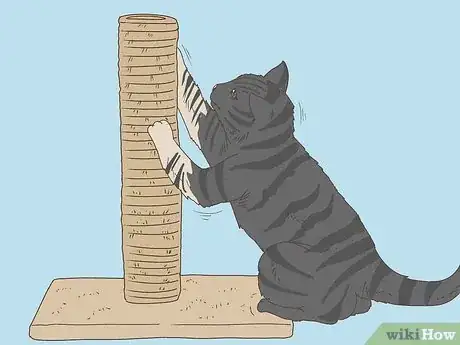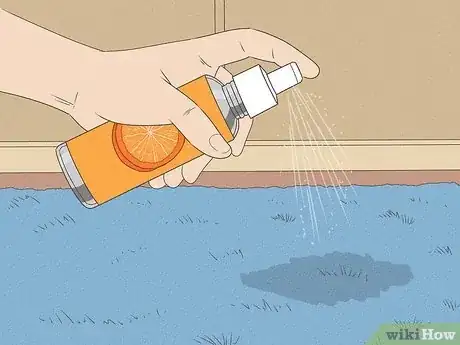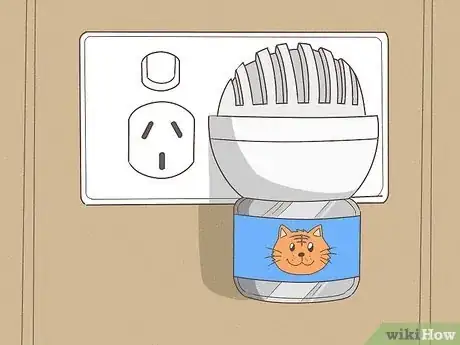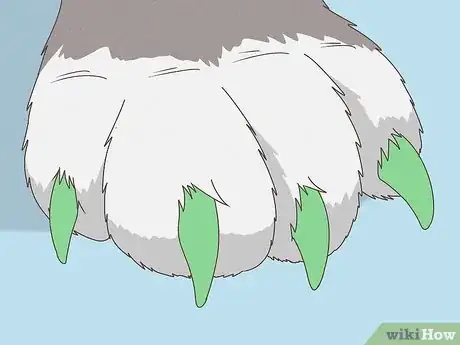This article was written by Molly DeVoss and by wikiHow staff writer, Glenn Carreau. Molly DeVoss is a Certified Feline Training and Behavior Specialist (CFTBS), a Certified Cat Behavior Consultant (CCBC), a Fear Free Certified Trainer (FFCT), and the Founder of Cat Behavior Solutions. Molly specializes in using positive reinforcement to modify and prevent unwanted behaviors in cats and reduce cat shelter surrender. Molly has sat on the Dallas Animal Advisory committee since 2013 and was voted one of the Top 12 Extraordinary Cat Behaviorists of 2020 by Catpetclub.com. She is certified by both the Animal Behavior Institute and the International Association of Animal Behavior Consultants. She is also the host of the weekly podcast Cat Talk Radio.
There are 8 references cited in this article, which can be found at the bottom of the page.
This article has been viewed 49,348 times.
Most cat owners will catch their kitty scratching at a patch of carpet sooner or later, but did you know that it’s a natural and healthy part of feline behavior? If you want to save your carpet and keep your cat happy, we’ve got you covered. There are many ways to easily lure a cat away from the carpet! In this article, we’ll show you how to redirect your cat’s behavior by giving them more appealing options to scratch, while also making the rug less tempting.
This article is based on an interview with our certified feline training and behavior specialist and certified cat behavior consultant, Molly DeVoss, founder of Cat Behavior Solutions. Check out the full interview here.
Steps
Set up a scratching post.
-
Cats need to scratch for their health, so give them a place to do it. Accept that your cat will always instinctively scratch to groom their claws. However, they won't scratch the carpet if you give them an alternative, such as designated scratching posts in each room with carpeting. To reinforce good behavior, give your cat a treat when you see them using the scratcher correctly.
- Pick a scratching post that is sturdy and tall enough for your cat to stretch out when using it, as they often enjoy a full back stretch.
- Place the scratcher either next to the cat's bed or next to areas of the carpet that they normally scratch to redirect their attention and make sure it's accessible. Your cat may just be scratching the rug for convenience!
Provide a variety of scratchers.
-
Try differently shaped and sized scratchers to see what your cat likes. Often, if a cat isn't interested in a post, horizontal scratchers are an appealing alternative. They can also double as beds, and some are designed for cats to rest on after scratching. You could also try a hanging cat scratcher, or an unusually-shaped post that looks more interesting than a regular scratcher.[1] X Trustworthy Source American Society for the Prevention of Cruelty to Animals Leading organization dedicated to the prevention of animal cruelty Go to source
- Try different materials, too. Scratchers can be made using cardboard, carpet, sisal, upholstery, and more. You never know what your cat will prefer when given a choice.
Rub catnip into the scratcher.
-
Catnip-scented scratchers attract cats so they don't scratch the rug. If simply placing a scratcher in a convenient location isn't redirecting your cat's attention enough, consider sprinkling some catnip on the scratcher. This will make the scratcher more appealing and lure your cat into using that instead of the carpet.
- Alternatively, you could try Feliscratch, a product that mimics cat pheromones to attract cats over to the scratching post.
- Hanging toys on the scratcher can also draw cats over.
Keep your cat's claws trimmed.
-
Cats scratch to keep their claws short, so a trim is helpful for them. Gently hold your cat's paw when you trim their nails and give them a treat after each successful clip. Take care not to cut the quick, which is the solid pink park of the claw where nerves and blood are; stick to the nail's white, partially clear area.[2] X Trustworthy Source American Society for the Prevention of Cruelty to Animals Leading organization dedicated to the prevention of animal cruelty Go to source
- It's easiest to clip your cat's nails when they're relaxed and sleepy and get them used to the sound of the nail clippers beforehand.
- If you don't feel confident clipping your cat's nails, a veterinarian or groomer can easily do it for a small fee.
- Declawing your cat is ultimately painful and unnecessary, as it involves removing the tip of your cat's finger. Steer clear of this procedure and remember that there are better ways to stop a cat from scratching![3] X Trustworthy Source The Humane Society of the United States National organization devoted to the promotion of animal welfare Go to source
Cover up the carpet.
-
Place obstacles or furniture over the spot your cat likes to scratch. If they ignore the scratching posts you put up, deter your cat from scratching by simply making sure they can't. Often, cats will pick a particular spot on the rug and scratch there; cover it with a chair or couch, or even a horizontal scratcher, so your cat has no choice but to use it.[4] X Trustworthy Source American Society for the Prevention of Cruelty to Animals Leading organization dedicated to the prevention of animal cruelty Go to source
Spray the carpet with a citrus scent.
-
Cats don't like citrus, so a spray can make them avoid the rug. They have powerful noses that are very sensitive to odors—and luckily, cats dislike a few enjoyable scents for humans. Use a citrus spray or another scented spray that will smell bad to your cat, and spray it over the carpet. There are even some specifically-designed cat deterrent sprays you can invest in.[5] X Research source
- Other scents cats dislike include lavender, peppermint, and lemongrass.
- You probably won't smell much (and it'll dissipate fast if you do), but your cat will smell it for days.
Redirect the cat with fake pheromones.
-
Apply a product that mimics pheromones to problem areas of the rug. Pheromones can also fool your cat into thinking another cat has already laid claim to the rug, causing them to retreat. You can also use plug in diffusers that imitate hormones to generally calm your cat down, making them less likely to scratch.
- Don't worry about smells; humans' weaker noses can't smell the pheromone spray.
Clean the carpets.
-
A cat might return to scent-marked carpets, so wash them regularly. This also applies to visible marks, which cats can spot and return when they want to scratch. You don't have to do anything too intense for this: just wash spots with clean, cool water and soap. If necessary, you can use a pet odor neutralizer when you're done to make sure it doesn't still smell like your cat.[6] X Trustworthy Source The Humane Society of the United States National organization devoted to the promotion of animal welfare Go to source
- Cleaning chemicals like ammonia and vinegar might motivate your cat to mark the area with their scent again, so avoid using them.
Keep your cat calm and happy.
-
Give your cat toys, affection, and stimulation to reduce their anxiety. Make sure your cat is content by playing with them daily, ensuring that there's enough food and water to go around, and showering them with love and attention when they behave. This will stop them from being destructive out of boredom or anxiety, which can happen when your cat wants more time with you.
- Get toys that encourage your cat's hunting drive, such as a toy on a string.
- Aside from the basics, cats get stressed when introduced to a new feline member of the household. Introduce them slowly to help your cat acclimate with as little anxiety as possible.
Make sure each cat has their own space.
-
Provide a scratching post for each cat you have. Position each cat’s scratch close to their favorite napping spot for easy access; this way, your cat can wake up and use the scratcher to stretch out. Cats like to be solitary and should each have a designated spot to go take care of their claws. If your cat has to compete, they may wander over to the carpet for a scratch instead.
Train new kittens to use scratching posts.
-
Kittens won’t learn to scratch the rug if you give them a place to do it. Cats learn through experience, so a young kitten can be taught to use a scratching post before the carpets become an issue.[7] X Research source Have scratchers available when you bring your kitten home for the first time, and use either treats or a little catnip to provide incentive right off the bat.
- Even if your kitten seems relatively calm, remember: all cats need to scratch, so it's not a question of "if," but rather where you want them to do it.
Get nail caps for your cat’s claws.
-
Nail caps are a harmless and painless way to blunt your cat’s claws. Use nail cap glue to bind these soft vinyl caps to each claw and let your cat scratch away! Your cat won’t leave behind any marks with nail caps, and they can still extend and retract claws as usual. Replace the caps every 4 to 6 weeks when they start to lose effectiveness.[8] X Trustworthy Source The Humane Society of the United States National organization devoted to the promotion of animal welfare Go to source
- If you don’t feel confident applying the nail caps, a veterinarian or groomer can do this for you.
- Keep in mind that nail caps aren’t ideal for cats that spend time outdoors, as they take away the cat’s main defense mechanism.
- Though nail caps don’t harm cats at all, not every cat reacts the same. Some may fuss over them for the first couple of applications, while others adjust effortlessly. Be patient and give your cat a few days to warm up to them.
You Might Also Like
 How to Keep Cats from Pooping in Your Yard
How to Keep Cats from Pooping in Your Yard



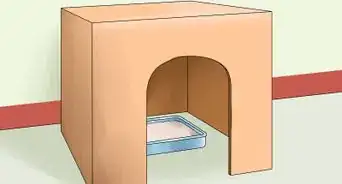







References
- ↑ https://www.aspca.org/pet-care/cat-care/common-cat-behavior-issues/destructive-scratching
- ↑ https://www.aspca.org/pet-care/cat-care/cat-grooming-tips
- ↑ https://www.humanesociety.org/resources/declawing-cats-far-worse-manicure
- ↑ https://www.aspca.org/pet-care/cat-care/common-cat-behavior-issues/destructive-scratching
- ↑ https://thescaredycat.com/whats-the-best-natural-cat-repellent/
- ↑ https://www.humanesociety.org/resources/how-remove-pet-stains-and-odors
- ↑ https://paw-rescue.org/scratching-post-training/
- ↑ https://www.humanesociety.org/news/clawful-truth-about-declawing
About This Article

